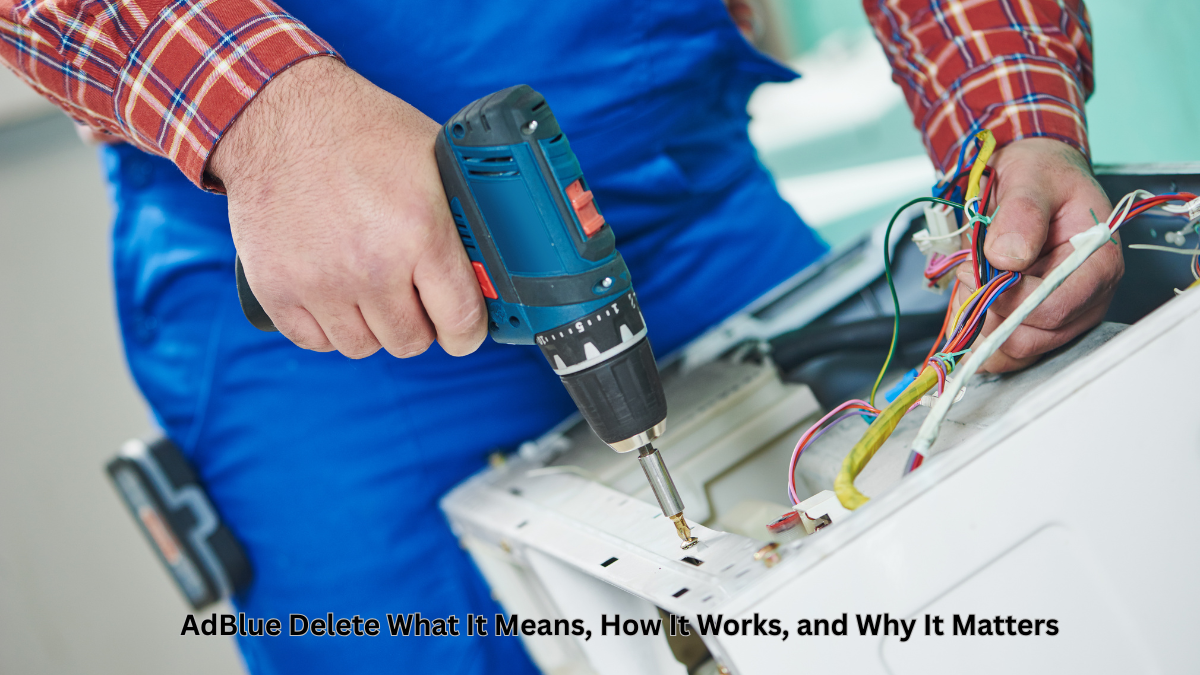In the world of modern diesel vehicles, the phrase AdBlue delete has become a point of intrigue, frustration, and controversy. Put simply, an AdBlue delete is a modification that disables or removes a vehicle’s selective catalytic reduction (SCR) system, which relies on AdBlue fluid to lower harmful nitrogen oxide (NOx) emissions. To many drivers, the concept promises lower maintenance costs and fewer roadside headaches. Yet beneath that appeal lie deeper issues—legal, environmental, and technical—that every driver, fleet manager, or automotive enthusiast should understand. Within the first few minutes of research, one thing becomes clear: an AdBlue delete is not just about saving on a fluid refill, but about reshaping how a vehicle interacts with modern environmental rules and long-term performance.
This article offers a detailed, 3,000-word exploration of what an AdBlue delete really is, how it works, the pros and cons, the regulatory landscape, and the implications for drivers and society.
Understanding AdBlue and Its Role
To grasp the concept of AdBlue delete, it’s essential to start with AdBlue itself.
AdBlue is a brand name for a liquid solution of 32.5% urea and 67.5% deionized water, designed to work with diesel engines equipped with SCR technology. When injected into the exhaust stream, it triggers a chemical reaction that converts nitrogen oxides into harmless nitrogen and water vapor.
The system was introduced widely in Europe after Euro 6 emission standards tightened the legal limits on NOx. Heavy trucks, buses, and increasingly passenger cars began using AdBlue tanks and injectors as part of their emissions control system.
The benefits are clear: without AdBlue, many diesel engines would not pass emission standards in regions with strict air-quality laws. But with those benefits come responsibilities: refilling AdBlue tanks, maintaining sensors, and ensuring that injection systems remain operational.
What Is AdBlue Delete?
An AdBlue delete refers to the practice of disabling or bypassing the SCR system so that the engine no longer requires AdBlue fluid to operate. This can be done through:
- Software reprogramming (ECU remap): Altering the vehicle’s electronic control unit to ignore AdBlue-related functions.
- Emulator devices: Installing a physical module that mimics the signals of the SCR system, tricking the ECU into thinking AdBlue is still being used.
- Hardware removal: Physically removing the SCR components, though this is less common due to complexity.
The appeal is immediate: once modified, the vehicle no longer prompts for AdBlue refills, no longer reduces engine power when the tank is empty, and no longer requires expensive maintenance of SCR injectors or sensors.
But here lies the dilemma: while convenient, this practice often breaches emissions laws, undermines air-quality regulations, and can lead to significant penalties.
Why Do People Consider AdBlue Delete?
The motivations behind this modification are varied, often practical, sometimes financial, and occasionally philosophical.
- Cost Savings
AdBlue itself is not prohibitively expensive, but frequent refills for fleet vehicles add up. Add in the costs of repairing malfunctioning SCR injectors or sensors, and the temptation to eliminate the system grows. - Reliability Concerns
Many drivers complain about system malfunctions that trigger limp mode, reducing engine power until the issue is fixed. In remote areas where service centers are scarce, this can be more than an inconvenience—it can be a business threat. - Performance Beliefs
Some enthusiasts believe bypassing emissions systems leads to smoother performance or improved fuel efficiency. While results vary, this remains a selling point for delete kits. - Skepticism of Regulations
A subset of vehicle owners resent government mandates and see AdBlue as unnecessary bureaucracy. Deleting it feels like regaining control of their machine.
The Risks and Consequences
While the short-term advantages may seem attractive, the long-term consequences of AdBlue delete are often underappreciated.
Legal Ramifications
In most jurisdictions, tampering with emissions systems is illegal. Fines can be significant, and vehicles may fail mandatory inspections. For fleets, non-compliance can damage reputations and contracts.
Environmental Impact
An AdBlue delete leads to significantly higher NOx emissions. Nitrogen oxides contribute to smog, acid rain, and respiratory diseases. The environmental cost extends beyond one vehicle—it affects the collective air quality in cities and towns.
Technical Concerns
Although some claim performance benefits, many vehicles experience unforeseen problems:
- Increased soot buildup in exhaust systems.
- Potential engine management errors.
- Reduced resale value, as buyers and dealers shy away from modified vehicles.
Insurance and Warranty
Tampering can void warranties and invalidate insurance claims. If an accident investigation reveals illegal modifications, liability issues become severe.
The Global Perspective
The debate around AdBlue delete is not confined to a single country. It reflects broader global struggles between regulation, innovation, and user behavior.
- Europe: Strict Euro 6 rules mean deletes are aggressively policed. Fines and inspections are common.
- United States: The Environmental Protection Agency (EPA) enforces emissions standards, with heavy penalties for tampering.
- Developing Regions: In countries with less enforcement, deletes are widespread, particularly in commercial fleets, reflecting economic pressures rather than environmental priorities.
This variation underscores how global supply chains intersect with local laws. A truck crossing from Germany to Poland may face entirely different enforcement levels, creating a patchwork of compliance challenges.
A Technical Look at the Process
To understand why deletes are tempting, it helps to know what happens under the hood.
SCR Components Involved in AdBlue Use:
- AdBlue tank
- Level sensor
- Pump
- Injector nozzle
- NOx sensor
- ECU monitoring system
When the system fails, repairs are costly. For example, a malfunctioning NOx sensor may cost hundreds of dollars, while injector failures can reach into the thousands.
By contrast, an emulator device may cost a few hundred dollars. The economic contrast drives demand.
Table: Comparing SCR System vs. AdBlue Delete
| Aspect | With AdBlue (SCR Active) | With AdBlue Delete |
|---|---|---|
| Emissions | Meets standards, lower NOx | High NOx emissions, fails standards |
| Legal Compliance | Fully compliant | Non-compliant, risk of fines |
| Maintenance | Requires AdBlue refills and SCR repairs | Reduced maintenance costs |
| Engine Management | Factory-supported settings | Risk of errors or instability |
| Resale Value | Higher | Lower due to modifications |
| Environmental Impact | Lower pollution | Higher pollution |
Is AdBlue Delete Worth It?
The short answer: for most users, no.
While the immediate benefits—lower costs, fewer maintenance headaches—are real, the downsides outweigh them in the long term. Drivers risk fines, loss of warranty, reduced resale value, and contributing to environmental harm.
Fleet managers, in particular, must weigh short-term financial savings against potential reputational and regulatory fallout.
The Future of Diesel and AdBlue
The debate over AdBlue delete reflects a bigger transition: the gradual move away from diesel altogether.
- Electrification: As electric trucks and buses enter fleets, the role of AdBlue diminishes.
- Stricter Laws: Governments worldwide are pushing for even tighter standards, making deletes riskier.
- Technological Improvements: SCR systems are improving, becoming more reliable, and less prone to failure.
This transition suggests that AdBlue delete may become a short-lived phenomenon, overshadowed by larger technological shifts.
FAQs
1. What happens if I run my car without AdBlue?
Most modern diesel vehicles enter limp mode, reducing engine power and preventing normal driving until AdBlue is refilled.
2. Is AdBlue delete legal anywhere?
In most developed regions, no. Even if enforcement varies, tampering generally violates emission standards.
3. Does AdBlue affect fuel economy?
AdBlue consumption is separate from fuel use, typically 3–5% of diesel consumption. The impact on fuel economy is minimal.
4. How often does AdBlue need refilling?
It depends on the vehicle, but usually every 5,000 to 10,000 miles for passenger cars, and more frequently for heavy-duty trucks.
5. Can AdBlue damage my engine?
No, AdBlue never enters the engine directly. However, poor-quality AdBlue or faulty injectors can damage the SCR system.
Conclusion
The story of AdBlue delete is not just about cars or trucks—it’s about the tension between individual convenience and collective responsibility. What looks like a small shortcut in the garage translates into larger implications for air quality, legal compliance, and future technology.
As societies demand cleaner air and automakers pivot toward electrification, the space for AdBlue delete is shrinking. Drivers and fleets must ask themselves: is the temporary relief worth the long-term risk?











